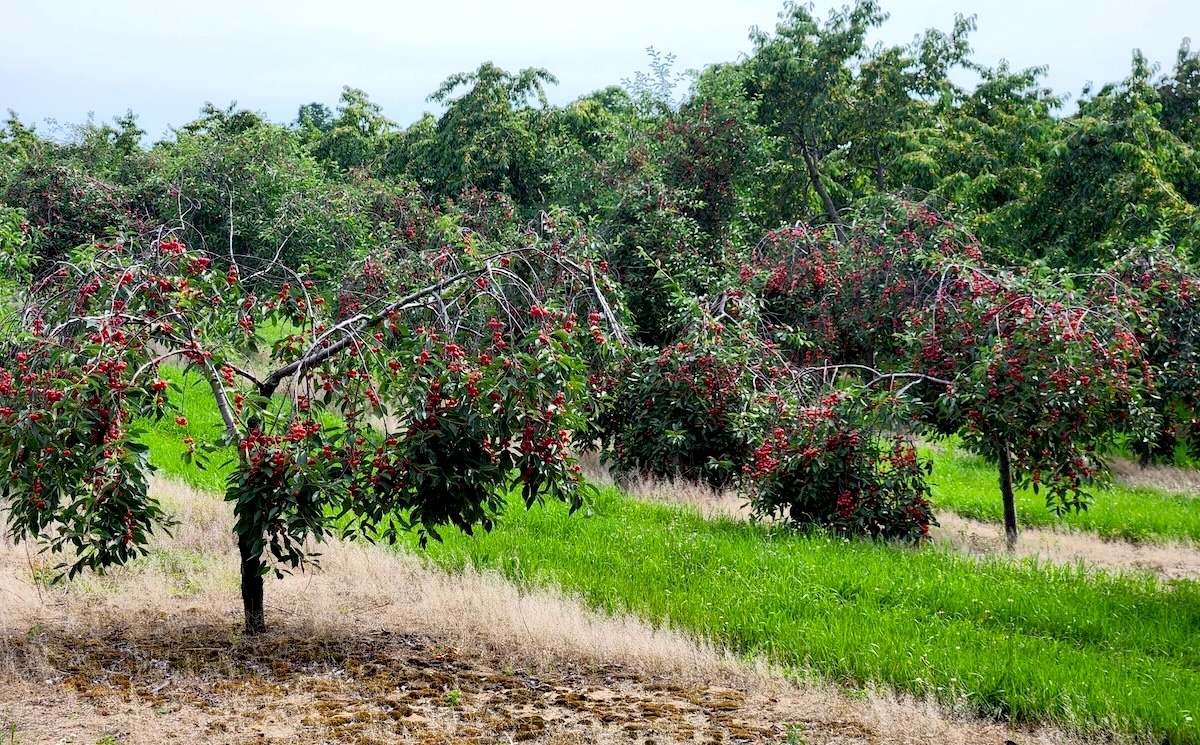
Strange and Severe Weather Threatens Local Agriculture Now More than Ever
Rain, Rain Go Away (But Not Too Far Away)
By Art Bukowski | Aug. 2, 2025
Local farmers face no shortage of challenges these days.
There are broad, long-standing problems like increased pressure to sell for development, declining interest from the next generation, and decreased prices due to competition from imported products. Then there are more acute issues like inflation driving up input costs, uncertainty about the labor market due to current immigration policy, and continuously fluctuating crop prices.
But chat with Nikki Rothwell, arguably the most in-the-know person when it comes to local agriculture, and one challenge overshadows all the others: wild, unpredictable weather.
Rothwell is the longtime coordinator of Michigan State University’s Northwest Michigan Horticultural Research Center (the “Hort Station”) in Leelanau County, and in that role she’s in constant touch with scores of farmers throughout the region.
What she’ll tell you is that weather events—frosts, hail, excessive moisture that breeds disease, and more—are causing problems at a much more frequent pace than in years past, and that these problems are posing a serious and growing threat to farming operations.
“The weather is really, really challenging again this year, and it’s been challenging [for a while now],” she says. “All the stars aligned for so many years, but now I feel like we can’t get a handle on all of these changes. Weather is our biggest challenge.”
Unpredictable Patterns
Rain is good, right? Yes, but to a point. A big problem this year has been a ton of rain that has led to very favorable conditions for diseases and pests.
“We just can’t seem to stop disease,” Rothwell says. “It’s been really warm and wet and muggy, and we’re really struggling with that. It’s putting tons of disease and insect pressure on growers.”
This is, perhaps ironically, after a lack of rain in some areas last year put a major strain on fruit trees. And an early frost this year that wiped out a good portion of the region’s tart cherry crops (if the frost comes after the buds are out, it kills the fruit). And hail that subsequently damaged the remaining cherries, along with apples and other crops.
Part of the problem is that the problem is always different, making mitigation tactics difficult and costly. And weather issues are becoming more frequent, causing farmers to brace for impact nearly every single year.
Travis Bratschi grows high-density Honeycrisp and Gala apples in Williamsburg. He’s been growing there about 15 years, and he says things have taken a marked turn for the worse even in that short time.
“When I first started, there was a guy selling hail insurance, and I said ‘Who buys hail insurance? It never hails,’” he says. “And I think we’ve had hail five out of the last 10 years.”
Hail can damage Bratschi’s apples, forcing him to sell them for processing instead of the fresh fruit market, which means lower prices paid for his crop. He’s also experienced hail so hard it has damaged the trees itself, leaving “battle wounds” that hamper production of those trees in the future.
“It’s a real concern. I don’t care what side of the fence you’re on, global warming [or not], but something has changed in our weather pattern, and it’s creating a lot more variability,” he says. “We had a once-in-a-hundred year freeze in 2012 right after it happened in 2001. These are not one-in-a-hundred year events anymore. They’re more normal.”
Juliette King-McAvoy of King Orchards in Antrim county, which grows cherries and a wide variety of other produce, echoes those concerns. Weather-driven crop losses have become “increasingly common to an alarming degree,” she says, and she’s also worried about the long-term effects of climate change.
“We had a crop disaster in 2001, and then in 2012, and then back-to-back in 2020 and 2021,” she says. “Even if you’re saying only one out of every 10 years is a crop failure, that’s not a viable business model for most people.”
Jim Bardenhagen grows apples, hay, wine grapes, and more on 80 acres in Leelanau County. He’s struggled this year with the moisture, and not just because of the pests and diseases it promotes. “This spring, we just couldn’t cut hay,” he says. “It was just raining all the time [and too wet]. So the hay got large and overmature.”
Again, it’s not necessarily this season that bothers him—it’s the patterns from year to year.
“We’re seeing larger amounts of rain when it does rain,” he says. “I don’t remember having three inches of rain in years past. We had an inch the other day, but people a couple miles from us had three inches. So when we do get something, it always seems to be more severe. The wind seems to be stronger, and we seem to get far more moisture when we get it.”
Beyond its physical impacts to the crops themselves, Bardenhagen says, weather is also having an increasingly detrimental impact on pollinating conditions for bees and other insects.
Insult to Injury
Rothwell believes that most of these issues are due to climate change, though she’s hesitant to even use the term considering the political leanings of some farmers. Still, she says, a time comes when you have to call a spade a spade.
“I know some people are like, ‘Oh, it’s cyclical,’” she says. “Well, I guess, but as a farmer, how long can you wait out a cycle, especially in a perennial crop system?”
She’s also distressed by continued and projected cuts to various federal programs that support vital research.
“I feel like we’ve got to just understand it better, and taking away funding for climate research or weather research or disease research is just going to put a ton more pressure on farmers,” she says. “They’re going to be managing blindly if we don’t have research to support what we do, especially in specialty crops where we don’t have a lot of outside funding.”
Indeed, local farmers speak highly of the Hort Station’s output, and some are no doubt worried about funding for this longstanding institution.
“The research station is continually looking for disease resistant broodstocks and varieties to help combat [various problems],” Bardenhagen says.
Ultimately, Rothwell says, funding for her station and other research outfits will be critical if farming and farmland is to be preserved in the decades to come.
“What it all goes back to is finding ways to keep growers profitable,” she says. “You can’t keep farming at a loss and thinking that these farms are going to be around for another 50 years.”
A Voice for Change
Leisa Eckerle-Hankins is the latest in a long line of Leelanau County farmers, and she for one is not scared of terms like “climate change.” She recently founded the Michigan Cherry Grower Alliance, a group that aims to give a collective voice to local farmers and that has been vocal about the long-term threat posed by climate change.
“I’ve always said there should be no politics in farming. It’s nonpartisan. I will speak to Republicans, I will speak to Democrats,” she says. “I know there’s [a taboo with the term climate change], but I’m sorry, if you’re a grower right now, you know that your crop is being affected by the weather…and it’s getting worse and worse.”
Among larger goals of advocating fiercely for farmers, Eckerle-Hankins says her group can also fight to preserve or increase funding for important research that helps farmers combat climate-driven problems.
“Continued research will only help us. And without it, it’s only going to get worse,” she says. “People like my son and I are not researchers. We know that we need something to help combat these problems, but we’re not the people to say what it might be. That’s Nikki’s area. She and her group are instrumental.”
Trending

Gaming That’s Out of This World
Anyone with an appreciation for the late 1970s and 1980s might enjoy the sound of vintage video games and their incredible l… Read More >>
Anxiety, Screens, and Self-Esteem
If adulting feels hard sometimes, let it be a reminder that growing up can be, too. Data from the National Alliance on Ment… Read More >>
Hope for the Holidays
This time of year isn’t always the easiest for many folks in our community, especially when they’re grieving the… Read More >>


